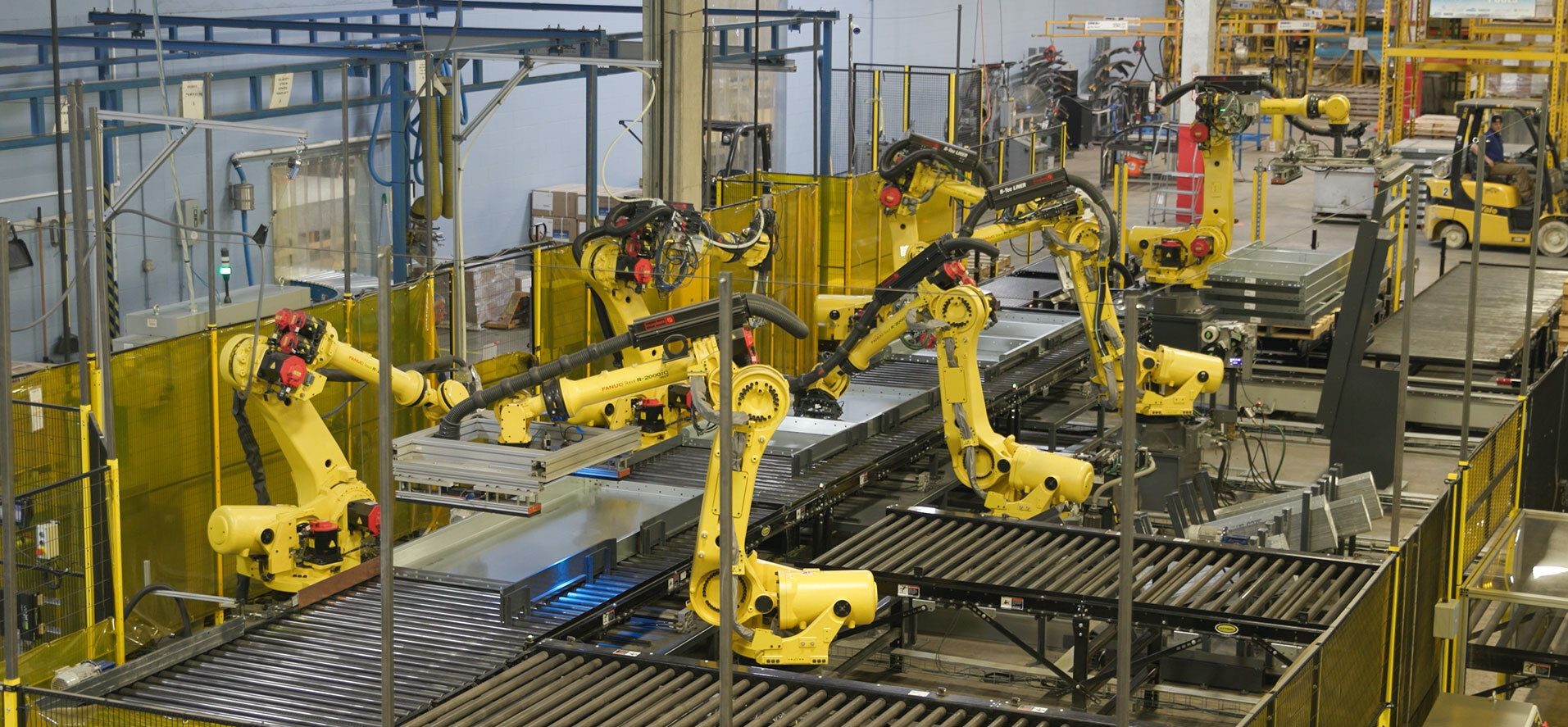ROBOTICS REVIEW
CONTACT
Austin

Lightweight battery-powered aircraft are ready for take-off.
New Technology Enables Robots to Process Moving Parts
Austin Weber // Senior Editor // webera@bnpmedia.com
A new real-time guidance system uses artificial intelligence and 3D vision technology to help robots make decisions in unstructured environments. Photo courtesy Inbolt
Traditionally, industrial robots interact with fixed parts and static workpieces. But, new technology recently developed in France allows six-axis robots to work on moving parts on assembly lines.
The system enables screw insertion, bolt rundown and other tasks that are challenging applications for traditional robotics. It also tackles real-world constraints such as crowded workstations, variable parts and variable part position.
That’s something that has been notoriously difficult for automation to accomplish in the past without massive infrastructure upgrades, expensive fixtures, cycle time compromises and constant maintenance.
A start-up company called Inbolt recently unveiled a real-time guidance system that uses artificial intelligence and 3D vision technology to enable robots to make autonomous decisions in uncertain and unstructured environments. Using a standard 3D camera, it enables robots to adapt to their environment, making automation more flexible, reliable and efficient.
General Motors was the first U.S. manufacturer to adopt the system in it is factories, while other companies, ranging from Airbus to Whirlpool, are also using Inbolt’s technology across various assembly applications.
“Processing moving parts is difficult, because traditional robots rely on static positioning,” says Albane Dersy, chief operating officer at Inbolt. “They need parts to be in the exact same place every time.
“On moving lines, even slight shifts in speed, position or orientation can break the automation,” explains Dersy. “We solve this with a real-time 3D guidance system and an ultra-fast AI model that continuously updates the robot’s trajectory. This lets [machines] adapt to changing environments and maintain precision at full line speed.”
Inbolt enhances quality by enabling robots to perform precision tasks like screw insertion or bolt rundown with consistently high accuracy, even when parts are moving or slightly misaligned. A real-time 3D vision-guidance system continuously monitors object position and orientation, so a robot can dynamically adjust its path. This reduces errors, rework and quality control issues caused by misalignment or variation on the line.
“Our system can be used for adhesive dispensing, riveting, screwdriving or welding,” claims Dersy. “However, most of our customers are using it for pick-and-place applications, such as line loading and machine unloading.”
Dersy and her colleagues recently collaborated with engineers at Fanuc America Corp. and General Motors to develop a vision-based system that enables six-axis robots to think and act spontaneously.
Robots can now perform material handling and other tasks on moving assembly lines. Photo courtesy Inbolt
“Our software takes over control of the machine’s trajectory at a very high frequency so that we can adapt to changing production environments found on continuously moving assembly lines,” says Dersy. “Robots such as Fanuc’s CRX cobot can operate with real-time 3D vision and adaptive trajectory correction, even with part variation or imperfect environments.”
GM is the first company to adopt the new technology, which relies on Fanuc’s Stream Motion real-time motion interface to enable a lightweight, robot-mounted vision system to take over the control of the machine’s path.
“Stream Motion allows external inputs to continuously update a robot’s trajectory via Ethernet,” explains Dersy. “What makes it powerful is its ability to support dynamic control loops. When paired with [our] guidance system, robots can adapt their motion live, enabling them to work on moving parts without stopping or reindexing.
“Like other large automakers, GM is attempting to automate the last frontier of automation, which is moving assembly lines,” notes Dersy. “But, doing that in a brownfield plant can be challenging, because it’s expensive to retrofit entire lines.
“Our primary goal is to reduce the complexity of automation,” says Dersy. “Using our technology, automakers can now automate some workstations and assembly tasks for productivity improvements.”
“This [system] gives car manufacturers a new level of automation: precision tasks performed by robots on lines that never stop,” adds Rudy Cohen, CEO of Inbolt. “No more expensive indexing. No more undue complexity and maintenance challenges. Just robots operating in a continuous motion environment and a huge leap forward for automakers’ general assembly shops.”
The vision-based system enables six-axis robots to think and act on the fly. Photo courtesy Inbolt
According to Cohen, Inbolt’s system operates up to 100 times faster than conventional options. “It’s also designed to scale across diverse production needs, whether for manufacturers worried about maintenance or line throughput, or system integrators’ requirements for easy and quick installation,” he points out.
Inbolt uses AI to interpret 3D vision data in real time.
“Our localization model rapidly identifies the position and orientation of parts, even with variation or in cluttered environments, and updates the robot’s path on the fly,” explains Dersy. “The AI model is pretrained and then fine-tuned on CAD data, so it can recognize a wide range of part geometries and generalize across multiple references.
“Our vision system is mounted directly on the robot and captures 3D data of the station in real time,” says Dersy. “This depth information is processed by AI to detect exact part positioning. Unlike traditional vision setups, there’s no need for fixed lighting or controlled environments. It works in variable, real-world conditions and enables robots to adapt in place.”
In the automotive industry, Inbolt is being deployed in various stationary workstations such as deracking in body shops. It overcomes challenges of misplaced parts to eliminate pick errors and downtime without the need for mechanical rework. It’s also being used in power train assembly plants for installing fasteners in engines and dispensing sealants.
“However, where Inbolt stands out is with final assembly lines, arguably the most challenging stage to automate due to constant movement and variability,” claims Dersy. “A typical use case here is screwdriving or bolt insertion on parts moving down the line, such as car doors. With manufacturers like Stellantis, we’re enabling robots to perform these tasks with precision and without stopping the line, something previously thought only a human could do.”
In addition to working with GM and Stellantis, Inbolt technology is in use at other automakers, such as Ford and Toyota, plus Tier One suppliers like Borg Warner and Magna. And, the company has been deploying its technology on robots made by companies other than Fanuc, including ABB, Kawasaki, Kuka and UR.
“A company with Ford’s scale can really influence the supply chain and business practices across our entire industry,” adds Sue Slaughter, purchasing director at Ford Motor Co. “It is so important that we not only think about how [we] can use our purchasing power to fuel our business needs, but also to advance sustainability.”
Because the automotive supply chain is extremely complex, the Guiding Principles contain expectations about business ethics, working conditions, human rights, health and safety, environmental leadership and supply chain due diligence for suppliers at all tiers. All suppliers are expected to uphold these standards and enforce them throughout their supply chain.
The Guiding Principles are based on fundamental elements of social, environmental and governance responsibility that are consistent with applicable laws and international standards created by organizations such as the United Nations.
Topics covered under the revised guidelines include the following:
Business ethics, including counterfeit parts and data protection.
Environmental issues, such as air quality, carbon neutrality, chemical management, circularity and water management.
Health and safety issues, such as personal protective equipment and workspace.
Human rights and working conditions, such as benefits, wages and working hours.
Responsible supply chain management, such as ethical sourcing of raw materials.
The BMW Group has implemented several projects in its packaging logistics unit to help the environment and conserve resources. The goal of the initiative is to work closely with suppliers to reduce carbon emissions and adhere to the principles of a circular economy.
BMW’s European assembly plants are using more recycled material in their packaging. For newly awarded contracts, the proportion of recycled material in reusable packaging for logistics purposes will almost double this year from around 20 percent to over 35 percent.
Using alternative sustainable materials, reducing single-use packaging, introducing lightweight packaging in certain areas and reducing transport volumes will also help cut carbon emissions.
BMW is monitoring the impact of individual measures via a CO2 calculator for packaging. The automaker’s overall aim is to reduce CO2 emissions in the supply chain by 20 percent per vehicle compared to 2019.
“Our re:think, re:duce, re:use, re:cycle approach is being implemented consistently in packaging logistics,” says Michael Nikolaides, head of production network and logistics at BMW Group. “We’re using innovative strategies to consistently reduce the volume of resources we use, thus reducing our carbon footprint.
“We are also doing our part to get the BMW iFACTORY up and running, with a particular focus on the ‘green’ side of things…with an emphasis on flexibility and efficiency, sustainability and digitalization,” explains Nikolaides. “It provides an answer to the challenges involved in the transformation to e-mobility and [leverages] the latest technologies to create a production process that uses minimal resources.”
According to Nikolaides, BMW is using more recycled material, such as expanded polypropylene (EPP) packaging. “Our newly developed EPP packaging already contains 25 percent recycled material,” he points out. “EPP is used in special containers, as its shape can be adapted to the components being packaged, allowing them to be transported safely.
“Around 360,000 of these containers are needed each year,” claims Nikolaides. “Using 25 percent recycled material allows us to save almost 280 tons of CO2 annually. There are plans to increase this proportion of recycled material even further, with the first pilot schemes with 100 percent recycled material currently underway. If these tests are successful, this configuration will become standard for new contracts from 2024.
“An additional 680 tons of carbon emissions savings can be made every year by using covers and so-called small load carriers with 50 percent recycled contents,” says Nikolaides. “As things stand, these measures are focused within the European markets due to the current waste management situation and available recycling infrastructure. But, we are working toward expanding to our locations in China, Mexico and the United States.”
BMW also plans to use folding large load carriers in place of traditional pallet cages made of steel. The plastic alternatives will be made from over 90 percent recycled material. They work in a similar way to the collapsible shopping crates that most people are familiar with.
When they’re empty, the carriers can be folded up, making them easier to transport. Nikolaides claims that using 15,000 of these new containers will reduce CO2 by around 3,000 tons per year.
“When it comes to packaging, the sky’s the limit,” says Nikolaides. “We’re launching pilot projects using bio-based materials to replace oil-based substances such as polyethylene and polypropylene.
“We are also investigating whether and in what ways we can use materials from recycled household appliances in our packaging,” explains Nikolaides. “In the long term, our aim is to use alternatives to raw materials across the board.”
BMW Initiative Targets Sustainable Packaging
BMW is using sustainable packaging in its assembly plants. Photo courtesy BMW Group
ASSEMBLY ONLINE
For more information on assembly robots, visit www.assemblymag.com to read these articles:





